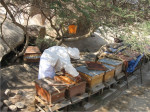Development of breeding programmes for endangered bee races, taking A. m. syriaca in Syria as an example
| Funding code: | ||
| Acronym: | ||
| Involved employees: | M.K. Zakour, Prof. Dr. K. Bienefeld | |
| Co-operation partners: | ||
| Duration: | 2006 -2011 | |
| Financing: | Syrian Ministries of Agriculture and Higher Education |
Worldwide, the population of indigenous bee races is declining in favour of heavily bred European bee races (Apis m. Carnica and Apis m. ligustica). Since the other races were not selected, or only to a limited extent, they are inferior to the aforementioned European races in terms of performance and behaviour. In general, indigenous breeds not only exhibit an optimal adaptation to the climate but also to the diseases in the respective countries. However, beekeepers can only be convinced to continue breeding local races of bees if they can compete with European bee races in terms of performance and behaviour, in addition to their better adaptation. Breeding indigenous races is the only way to guarantee this. Using the example of Syria, this project serves to map out the conditions in a typical emerging nation and lay the foundation for establishing the necessary infrastructure required for a positive selection response in the honey bee. By means of model calculations, the importance of individual factors to selection response is to be quantified. Thus, any results can provide suggestions for other countries with suboptimal conditions.
Publications:
- Zakour, M.K.; Ehrhardt, K.; Bienefeld, K. (2012) First estimate of genetic parameters for the Syrian honey bee Apis mellifera syriaca. Apidologie 43 (5), 600-607
- Zakour,M. K.; Bienefeld, K (2013) Subjective evaluation of defensive behavior in the Syrian honeybee (Apis mellifera syriaca). Journal of Apicultural Science 57(2), DOI: 10.2478/JAS-2013-0002


